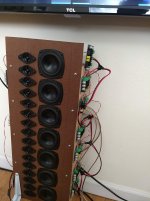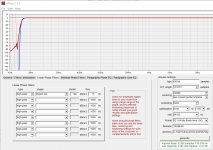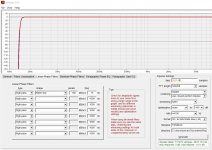I'm curious as to how many board members use active crossovers?
At least a 2 way?
How about 3 way systems ?
With a full blown 4 way, being of course, the cat's meow 🙂
I'm curious on this because, it seems to me, that around 1980 there were several active crossovers on the market, but these days, other than Marchand, not so much. Or am I missing something ?
From Sound Reproduction/Floyd Toole chapter 18
Some [good sounding loudspeakers] require monster monoblock power amplifiers to drive the current-hungry low impedances, sometimes the consequence of the complicated passive crossover networks required to smooth the frequency responses. This is much easier and better if done as equalization in electronics upstream of the power amplifiers, with the power amplifiers optimally designed to match the load conditions and power needs of individual transducers. And, active crossovers are vastly superior to passive versions. The monster monoblocks get replaced by a number of much smaller, simpler, amplifier modules. Modern equalizers can be as complex as needed, and because transducers are minimum-phase devices over their operating frequency ranges a smooth frequency response is a good indicator of freedom from transient misbehavior.
I have ten amplifiers on this speaker that cost $1.50 each (in bulk, before amortizing cost due to failed boards.) Maybe somewhere around $1.65 after I eat failed amps. Cost could be as high as $1.80 per amp. But it's a joke because it's so insanely cheap even if there's a high rejection rate.
Because I use DSP + individual amplification I can build an array or column speaker on a whim. Stick a microphone on it and flatten frequency response to get the result Floyd Toole explains above. Consequently, I can think more in terms of soundfields than sweating over crossovers and frequency response.
Also, I think there's the matter of enjoying sound (music plus movie dialogue.) Building with DSP + amps = really good speakers with very little effort. That leaves more time to enjoy what comes out of the speakers. I think if you build good passive speakers you probably need to be in the mindset of a nitpicker. It seems like sort of a negative mindset that doesn't allow you to enjoy the music without criticizing some obscure failure in the design. With DSP if I hear something I don't like I just click a few things and it's gone. No doubt that causes problems in other places but I'm not listening to those problems at the moment so it doesn't bother me.
Attachments
^ Interesting, simple and cost effective project!
Obviously, Toole makes some valid points.
Personally I'd avoid current hungry, low impedance loudspeaker concepts/drivers altogether.
Obviously, Toole makes some valid points.
Personally I'd avoid current hungry, low impedance loudspeaker concepts/drivers altogether.
Last edited:
I think some of it has to do with the "mindset" of analog component stereo - separate function chassis connected with RCA cables, amplifiers connected to two speakers, each with a single wire pair. To break that paradigm (ingrained since the advent) is very difficult, as in "go out of business" prior to getting any traction against it.
I dont know of many amplifier components you can just go out and buy that have multiple outputs - say, 6 channels - which the ability to assign to each any portion of the full audio bandwidth desired - either done as all analog - for the RCA connected camp - or all digital - for the bit conveyors camp, Signal Processing.
I have the Zoudio amp in one of my systems; it's 4 channels with integrated DSP on each. It's an outlier product and - realistically - leaves the RCA connected camp out of the picture completely. For me, that's no issue as I've abandoned analog source maybe a decade ago. Still it's not something you'd find (or an equivalent) easily on "ebay" - where the RCA and USB and BT input amps that connect to a speaker with integrated crossovers are very abundant.
Consider even the HiFiBerry AMP2 I use in a 2nd system. The amplifier chip HAS the DSP built right into it; one would think you could stack those up to the ceiling with different boards outputting different bandwidths of the audio spectrum. Nope - they dont give that to you. Stereo, full bandwidth - connect it up to your integrated crossover speakers and there, you're good to go! HiFiBerry probably thinks only some wild, crazy fringe-user would want to do that!
I dont know of many amplifier components you can just go out and buy that have multiple outputs - say, 6 channels - which the ability to assign to each any portion of the full audio bandwidth desired - either done as all analog - for the RCA connected camp - or all digital - for the bit conveyors camp, Signal Processing.
I have the Zoudio amp in one of my systems; it's 4 channels with integrated DSP on each. It's an outlier product and - realistically - leaves the RCA connected camp out of the picture completely. For me, that's no issue as I've abandoned analog source maybe a decade ago. Still it's not something you'd find (or an equivalent) easily on "ebay" - where the RCA and USB and BT input amps that connect to a speaker with integrated crossovers are very abundant.
Consider even the HiFiBerry AMP2 I use in a 2nd system. The amplifier chip HAS the DSP built right into it; one would think you could stack those up to the ceiling with different boards outputting different bandwidths of the audio spectrum. Nope - they dont give that to you. Stereo, full bandwidth - connect it up to your integrated crossover speakers and there, you're good to go! HiFiBerry probably thinks only some wild, crazy fringe-user would want to do that!
Last edited:
Here are a couple of screen shots that demonstrate that really high tap counts might be called for if you ask for extreme filters.
I don't know if this is the sort of thing plasnu was talking about but it might illustrate the point. The screenshots show the difference between 65536 and 262144 taps on a 15Hz 192dB Highpass at 44100. When you don't use enough taps to properly describe the filter you can get some horrible phase issues outside the passband.
I don't know if this is the sort of thing plasnu was talking about but it might illustrate the point. The screenshots show the difference between 65536 and 262144 taps on a 15Hz 192dB Highpass at 44100. When you don't use enough taps to properly describe the filter you can get some horrible phase issues outside the passband.
Attachments
To generalize and put it brutally short:
If I need slopes steeper than 24dB I've picked the wrong drivers.
If I need slopes steeper than 24dB I've picked the wrong drivers.
I would rather put it that, if you need steeper slopes you have to have a very good idea of what you are trying to do with them! I don't so I won't 🙂
I think some of it has to do with the "mindset" of analog component stereo - separate function chassis connected with RCA cables, amplifiers connected to two speakers, each with a single wire pair. To break that paradigm (ingrained since the advent) is very difficult, as in "go out of business" prior to getting any traction against it.
The joy of DIY is that you can stick two fingers to the status quo and do it your way!
Tend to agree with both Englishmen, that is: at home with respect to 'more traditional loudspeaker systems'.
In the pro world, steep filters are common practice.
In the pro world, steep filters are common practice.
I would rather put it that, if you need steeper slopes you have to have a very good idea of what you are trying to do with them! I don't so I won't 🙂
Yes that is a much more diplomatic way of putting it. 😉
Ro I can see why one would go up to 48dB in a PA setting but at home I still think if you can't do it with 24 you're probably doing something wrong ie you are veering off the path of best engineering practice.
There could be reasons why you might want to do that, they are just escaping me for the moment.
^ Interresting conversion with NS1000!
The hardening in24db is hard to like without a small cut under the joint, compaired to 12db. Especially on digital filters which is super clean in whatever happens.
Power response comparison with Linkwitz-Riley crossovers
The hardening in24db is hard to like without a small cut under the joint, compaired to 12db. Especially on digital filters which is super clean in whatever happens.
Power response comparison with Linkwitz-Riley crossovers
Last edited:
Thanks for your reply btw!
So for a 2-way with an asymmetric / hybrid crossover FIR is preferable, or is this a borderline case?
You bet !
I'd echo Fluid's reply.
As he said, linear phase xovers are best used complementary, and least likely to make audible improvements in a low-order 2-way.
I completely agree with his point it's really a matter of how steep you want your xovers to be (and why).
For example on a 2-way, when we try to take a CD down as low as possible, I think a steep hpf helps do that by preventing potential excursion problems.
What sampling rate is that filter using as it makes a big difference to the relative number of taps. At 44.1 to 48K, those are long filters at 192K not so long.
I'm pretty sure that all the reputable digital filters oversample internally before filter processing. EQuilibrium works @4x as far as I know.
Every use case is different, to me it's more a matter of how steep you want your crossover slopes to be rather than how many ways the speaker is that would determine if an FIR is warranted, or if you are chasing a perfect impulse response.
Linear phase crossovers can be very easy to implement. Flatten the drivers for two octaves either side with PEQ, time align the drivers, bang a complementary LP crossover of whatever type in, done. The same thing can be done with an LR4 IIR crossover, that was the Linkwitz way and it works well too if the drivers have enough response outside their pass bands.
Hi Fluid,
You bring up the second method I alluded to in an earlier post, for making acoustic LR4 xovers.
The soapbox i didn't get on....Recommending out-of-band flattening along with complementary xovers.
I've found it so much easier and precise than the "nudge" method of adding filters via trial and error to get to the measured acoustic target.
And it has nothing to do with IIR vs FIR, or steep vs low order.
The electrical filter transfer function that the nudge method gives should be identical to the flattening filters and xover summed together,
when both methods provide the same acoustic driver response. (I know you know this, i'm just filling in for some folks following along for whom it might not be clear.)
Heck, it doesn't even require complementary xovers...
it's just a way of getting an acoustic xover to match an electrical xover.
I'd be using this technique even if i were into analog active....(which interestingly btw, all of Meyer's prosound boxes still are, afaict.)
I think the biggest problem with out-of-band flattening is it may require higher filter counts than are available.
Between however many EQ's are needed in-band, and usually at least 2-4 out-of-band EQ's for flattening per passband side,
it can be hard to find an IIR processor with that many EQ's available per channel.
I think this is an oft overlooked advantage of FIR.....the ability to embed essentially unlimited IIR filter's. (While still allowing the choice of minimum or linear phase xovers.)
The only thing you said i don't fully agree on is in the importance of the number of ways, in deciding whether to go with FIR and linear phase xovers.
Like the Linkwitz pages show, LR4's in a 4-way don't work without cascading and additional all-pass correction.
Even if those steps are done, there's just too much cumulative phase rotation from using 3 xovers, imo.
Hi Plasnu, i don't want to possibly offend or go down a rabbit hole that may have flames at the bottom.
Mark, the reason why I posted on this thread is it seems many people concluded digital filter sounds bad compared to analog counterpart after trying bad digital filter. My point is: not all digital filters sound the same, some bad, and some better, and in reality, I think most of them are bad.
Here are a couple of screen shots that demonstrate that really high tap counts might be called for if you ask for extreme filters.
I don't know if this is the sort of thing plasnu was talking about but it might illustrate the point. The screenshots show the difference between 65536 and 262144 taps on a 15Hz 192dB Highpass at 44100. When you don't use enough taps to properly describe the filter you can get some horrible phase issues outside the passband.
Thx fluid,
But Wow, that's pretty extreme alright !!!
Brick wall at 15Hz ?? 😱
Well, i'd sure love to have the subs that might need one 😀
Mark, the reason why I posted on this thread is it seems many people concluded digital filter sounds bad compared to analog counterpart after trying bad digital filter. My point is: not all digital filters sound the same, some bad, and some better, and in reality, I think most of them are bad.
Cool Plasnu,
thanks for the reply, and sorry for my rough edges sometimes 😱.... i can be a cranky old codger every now and then, or so my gf says 😛
By digital filters, do you just mean common ones like PEQ's, shelving, and xovers used for speakers?
Or are you also talking about sound sculpting filters used in mastering or live sound effects, etc ?
My mids and highs are passive 18Sound 6nd430s to Wavecore TW030s. The mids are active to AE td15s. I use Ashly amps and crossovers.
I use REW to adjust both crossovers and spend an hour or two adjusting the active crossover a day or more on the passive.
Those parts didn't require any EQ, the 6nd430 needed a low Q second order to flatten the rising response.
I also spent a lot of time with positioning. Mainly on the woofer box but still have two big dips.
My favorite system.
I use REW to adjust both crossovers and spend an hour or two adjusting the active crossover a day or more on the passive.
Those parts didn't require any EQ, the 6nd430 needed a low Q second order to flatten the rising response.
I also spent a lot of time with positioning. Mainly on the woofer box but still have two big dips.
My favorite system.
The maligned MiniDSP has 5 PEQ on each input and 5 on each output, all of which can be custom biquads. By the time people have used all of those and are still wanting you are clearly into 'expert user' territory (or a lost soul) and at least know what you want.I think the biggest problem with out-of-band flattening is it may require higher filter counts than are available.
Between however many EQ's are needed in-band, and usually at least 2-4 out-of-band EQ's for flattening per passband side,
it can be hard to find an IIR processor with that many EQ's available per channel.
Aside I don't recall having seen a mention of ultimateEqualizer on here. Is there no love for this?
Hi billshurv,
I guess i fit into the 'lost soul' bin ! 😀
It's cool the Minidsp has 5 input PEQs, and then 5 on each output.
Well thought out imo.
Virtually all prosound speaker processors have both input and output EQs.
I've never found a way to use the input EQs for speaker tuning though,
since driver-by-driver tuning can only use output channel EQs.
But i love input EQ's for putting a house curve on top of the speaker tuning, or for matching to a room.
Allows trying different house curves, different room settings, changing rooms, moving outdoors.... easily without need of further speaker tuning.
So for me, output EQs are about flat mag and phase in as near anechoic conditions as possible,
and input EQs are about tone control and mating the flat speaker to the room/environment.
we all have our own methods, huh ? 🙂
I guess i fit into the 'lost soul' bin ! 😀
It's cool the Minidsp has 5 input PEQs, and then 5 on each output.
Well thought out imo.
Virtually all prosound speaker processors have both input and output EQs.
I've never found a way to use the input EQs for speaker tuning though,
since driver-by-driver tuning can only use output channel EQs.
But i love input EQ's for putting a house curve on top of the speaker tuning, or for matching to a room.
Allows trying different house curves, different room settings, changing rooms, moving outdoors.... easily without need of further speaker tuning.
So for me, output EQs are about flat mag and phase in as near anechoic conditions as possible,
and input EQs are about tone control and mating the flat speaker to the room/environment.
we all have our own methods, huh ? 🙂
- Home
- Loudspeakers
- Multi-Way
- Are you ACTIVE ?? (multi-way)


